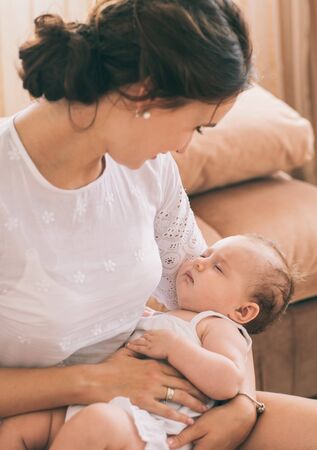1. Understanding Newborn Skin
If you’re a new dad (or mom!), one of the first things you’ll notice is just how soft and delicate your baby’s skin feels. But what makes newborn skin so different from ours, and why does it need special care? Let’s break it down in a way that’s easy to understand for any parent.
Why Is Baby Skin So Sensitive?
Newborn skin is about 20-30% thinner than adult skin. This means it doesn’t have the same protection as our skin and can easily lose moisture or get irritated. Plus, their immune systems are still developing, so their skin reacts more strongly to things like soaps, detergents, or even changes in temperature.
How Newborn Skin Differs from Adult Skin
| Feature | Newborn Skin | Adult Skin |
|---|---|---|
| Thickness | Much thinner and more delicate | Thicker, more protective barrier |
| Moisture Retention | Loses water quickly, prone to dryness | Better at holding onto moisture |
| Sensitivity | Easily irritated by products or fabrics | More resistant to irritation |
| Oil Production | Minimal oil production at birth | Regular oil production helps protect skin |
| Immune Defense | Still developing; less able to fight off irritants or germs | Mature immune response in skin |
Common Features You Might Notice on Your Newborn’s Skin
If you’re looking at your baby’s skin up close, don’t be surprised if you spot some of these common features—most are totally normal for American newborns:
- Patches of dry or peeling skin: Especially in the first few weeks as they shed their outer layer.
- Milia (tiny white bumps): These often pop up on the nose or cheeks and usually go away on their own.
- Bumps or redness: Sometimes called “baby acne,” this is very common and nothing to worry about.
- Mongolian spots: Flat, bluish-gray patches that often appear on the lower back or bottom (more common in babies with darker skin tones).
- Erythema toxicum: Red blotchy spots with a little white or yellow bump in the center—harmless and temporary.
- Lanugo: Fine hair covering parts of the body, especially if your baby arrived a bit early—this sheds with time.
The Takeaway for Parents:
Your baby’s skin needs gentle handling and extra protection because it simply isn’t built like ours yet. The good news? With a little know-how, you can help keep your newborn comfortable and reduce the chance of rashes, dryness, and other common issues as they grow.
2. Everyday Skin Care Basics
Taking care of your newborn’s skin doesn’t have to be complicated, but it does help to know a few basics. As a dad who’s been there, I can say that keeping things simple and gentle is usually best. Here are some practical tips for daily skin care, including what works well for most American families.
Gentle Cleansing Routines
Your baby’s skin is super delicate, so skip the harsh soaps and stick with lukewarm water or mild cleansers made just for babies. During diaper changes, use soft wipes or a damp washcloth—fragrance-free is key. If your little one gets messy (think spit-up or drool), gently dab the area instead of scrubbing.
How Often Should You Bathe Your Newborn?
Believe it or not, babies don’t need a bath every day. In fact, bathing two to three times a week is plenty unless they get especially dirty. Too much bathing can dry out their sensitive skin. On non-bath days, just give them a quick wipe-down with a soft cloth on their face, neck folds, and diaper area.
| Bathing Frequency | Recommended Approach |
|---|---|
| 2-3 times per week | Full bath with mild baby soap |
| Daily (if needed) | Sponge bath for face, hands, neck folds, and diaper area only |
Choosing Safe American-Made Products
With so many baby products on the market in the U.S., it can feel overwhelming. Look for brands that are pediatrician-recommended and made in America—this means they meet high safety standards. Go for fragrance-free and hypoallergenic options when possible. Here are some trusted choices:
| Product Type | Recommended Brand (American-Made) | Why Parents Like It |
|---|---|---|
| Baby Wash/Shampoo | Johnson’s Head-to-Toe Wash & Shampoo | Mild, hypoallergenic, easy to find in stores |
| Moisturizer/Lotion | Aveeno Baby Daily Moisture Lotion | Fragrance-free, gentle on sensitive skin |
| Diaper Rash Cream | Desitin Maximum Strength | Pediatrician recommended, effective barrier cream |
| Wipes | Pampers Sensitive Baby Wipes | No perfume, gentle cleaning power |
Quick Tips for Everyday Care:
- Pat dry after baths: Don’t rub; patting helps protect that new baby skin.
- Avoid overheating: Dress your baby in breathable cotton layers; too much heat can cause rashes.
- Diaper changes often: Change diapers promptly to avoid irritation and rashes.
- No powders needed: Skip talcum powder—it can irritate baby lungs.
- Watch for reactions: If you notice redness or bumps after using a product, switch to another gentle option.

3. Dealing with Diaper Rash
How to Prevent Diaper Rash
As a dad, I know diaper rash can sneak up fast and make your little one uncomfortable. The good news is, there are some simple steps you can take at home to help prevent it:
- Change diapers often: Try to change your babys diaper as soon as its wet or dirty. This keeps moisture and bacteria away from their delicate skin.
- Let skin breathe: Give your baby some diaper-free time during the day. Just lay down a towel and let them kick around for a few minutes—it helps keep their bottom dry.
- Gentle cleaning: Use warm water and a soft cloth or fragrance-free wipes when cleaning during changes. Avoid rubbing too hard.
- Avoid tight diapers: Make sure diapers fit snugly but not too tight. Tight diapers can trap moisture and cause friction.
When to Use Diaper Creams
Diaper creams aren’t just for when your baby already has a rash—they’re great for prevention too. Here’s when to use them:
- If your baby’s skin looks red or irritated after a change
- If your baby is teething or starting solid foods (these times can lead to more frequent rashes)
- Anytime you notice extra moisture or sensitivity
You don’t have to use cream at every single change, but if you see redness, it’s a good idea to apply a thin layer to protect the skin.
What to Look For in Diaper Rash Products (US Brands)
| Product Type | Main Ingredients | Popular US Brands | Notes |
|---|---|---|---|
| Zinc Oxide Creams | Zinc oxide (10-40%) | Desitin, Boudreauxs Butt Paste, A+D Original | Creates a protective barrier; good for mild to moderate rashes |
| Petroleum Jelly Ointments | Petrolatum | Aquaphor, Vaseline Baby | Locks in moisture; gentle on sensitive skin; good for prevention |
| Natural/Organic Creams | Aloe, Calendula, Coconut Oil | Burt’s Bees Baby, Earth Mama Organics | No artificial fragrances; suitable for sensitive babies |
| Creams with Antifungal Ingredients | Miconazole, Clotrimazole (OTC) | Lesser-known generic brands; ask your pediatrician first | Used only if pediatrician suspects yeast infection; not for routine use |
What to Avoid in Products
- Fragrances and dyes: These can irritate newborn skin.
- Talc-based powders: The American Academy of Pediatrics recommends avoiding talc due to potential lung risks if inhaled.
- Steroid creams: Only use these if prescribed by your doctor.
When to Call the Pediatrician?
If your babys rash doesnt improve after a few days of home treatment, gets worse, or you see blisters, pus, or open sores, its time to check in with your pediatrician. Sometimes diaper rash can be caused by an infection that needs special treatment.
4. Preventing Dry Skin and Eczema
Moisturizing Your Newborn’s Skin
As a dad, I know how important it is to keep your newborn’s skin soft and healthy. Babies’ skin loses moisture quickly, especially in dry climates or during winter when indoor heating is on full blast. Here’s what you can do:
- Apply moisturizer right after bath time. Pat your baby dry with a towel (don’t rub), then use a gentle, fragrance-free lotion while the skin is still a little damp.
- Choose products labeled “hypoallergenic” and “fragrance-free.” These are less likely to irritate sensitive baby skin.
- Avoid long baths. Keep bath time short—about 5-10 minutes—and use lukewarm water instead of hot.
Recognizing Early Signs of Dry Skin or Eczema
Early detection makes a big difference. Here are some signs that your baby might have dry skin or eczema:
| Sign | What It Looks Like |
|---|---|
| Dry Patches | Rough, flaky spots—often on cheeks, arms, or legs |
| Redness | Patches of red, irritated skin |
| Itchiness | Your baby seems fussy and scratches at their skin |
| Tiny Bumps | Small, raised bumps that sometimes ooze or crust over (common with eczema) |
Recommended Hypoallergenic Lotions for American Climates
The best lotion depends on where you live. Here are some popular options that work well in different parts of the U.S.:
| Lotion Brand | Main Benefits | Best For |
|---|---|---|
| Cetaphil Baby Daily Lotion | Mild, fragrance-free; contains organic calendula | All climates; sensitive skin |
| Eucerin Baby Eczema Relief Body Cream | Steroid-free; soothes itching and minor irritation | Dry or cold climates; eczema-prone skin |
| Aveeno Baby Daily Moisture Lotion | Naturally derived oat formula; gentle hydration | Moderate to humid climates; everyday use |
| CeraVe Baby Moisturizing Lotion | Ceramides for extra barrier support; non-greasy | Any climate; babies with sensitive or easily irritated skin |
Tips for Choosing and Using Lotions:
- If you notice any rash or irritation after using a new product, stop immediately and talk to your pediatrician.
- Avoid lotions with dyes, fragrances, or alcohol—they can make dryness worse.
- If your baby’s skin isn’t improving or seems to be getting worse, don’t hesitate to get professional advice.
Your baby’s comfort comes first—keeping their skin healthy is all about gentle care and paying attention to the little things.
5. Common Newborn Skin Issues
Spotting the Usual Suspects: Cradle Cap, Baby Acne, and More
If you’re a new parent in the U.S., chances are you’ll notice some weird stuff popping up on your baby’s skin during those first few months. Don’t panic—most newborn skin issues are totally normal and usually clear up on their own. Here’s a quick rundown of what you might see and what you can do about it:
Cradle Cap
This is that yellowish, scaly stuff that shows up on your baby’s scalp (sometimes eyebrows too). It looks kind of alarming but usually isn’t itchy or bothersome to your little one.
- What to Do: Wash your baby’s hair with a gentle baby shampoo a couple times a week. You can also use a soft brush to loosen the flakes. Don’t pick at it—let it come off naturally.
- When to Call the Pediatrician: If the cradle cap spreads, gets red and swollen, or seems painful for your baby, give your doctor a call.
Baby Acne
Those tiny red or white bumps on your newborn’s cheeks, forehead, or chin? Totally normal—blame hormones passed from mom before birth. Baby acne usually pops up in the first month or so.
- What to Do: Just keep the area clean with water and pat dry. Avoid lotions and scrubbing. It usually goes away by itself after a few weeks.
- When to Call the Pediatrician: If the bumps look like they’re filled with pus, spreading fast, or seem irritated, check in with your pediatrician.
Other Frequent Skin Conditions
| Condition | What It Looks Like | What To Do |
|---|---|---|
| Diaper Rash | Redness, irritation in diaper area | Change diapers often; use diaper cream; let baby have diaper-free time |
| Eczema | Patches of dry, itchy skin (often arms/legs) | Keep skin moisturized; use fragrance-free products; ask doc for advice if severe |
| Milia | Tiny white bumps on nose/cheeks | No treatment needed; will go away on its own |
| Erythema Toxicum | Blotchy red spots with yellow/white center (first week of life) | No treatment needed; harmless and temporary |
When Should You Worry?
If you notice any of these signs, it’s time to call your pediatrician:
- Your baby’s skin is blistering or peeling off in big patches.
- The rash is oozing, bleeding, or has yellow crusts.
- Your baby has a fever along with the rash.
- The skin looks very swollen, warm, or painful to touch.
- You just feel something isn’t right—trust your gut!
The good news? Most newborn rashes and bumps are part of growing up and will fade as your little one adjusts to life outside the womb. Still, when in doubt, always reach out to your child’s doctor—that’s what they’re there for!
6. When to See a Doctor
As a parent, its totally normal to worry about your newborns skin—after all, their skin is so delicate and new! Most little rashes and dry spots are nothing to stress about, but sometimes you do need to get a doctor involved. Heres a straightforward guide to help you know when its okay to just keep an eye on things, and when its time to call your pediatrician.
Common Minor Skin Issues
Most newborns will have some kind of skin issue in the first few weeks, like peeling skin or tiny bumps. These usually clear up with gentle care at home. Heres a quick overview:
| Skin Issue | What It Looks Like | What To Do |
|---|---|---|
| Peeling skin | Flaky, especially on hands and feet | No treatment needed; use gentle moisturizer if desired |
| Baby acne | Tiny red bumps, mostly on face | Usually clears on its own; don’t scrub or use adult acne products |
| Erythema toxicum | Yellow or white bumps with red skin underneath | No treatment needed; goes away in days/weeks |
| Milia | Tiny white dots, often on nose or cheeks | No treatment needed; will fade on their own |
When to Watch More Closely
Sometimes a rash or dry patch might be more than just a harmless newborn issue. Keep an eye out for these signs that mean you should call your babys doctor:
- The rash is spreading quickly or getting worse
- Your baby seems very uncomfortable or is crying more than usual because of it
- You notice blisters, open sores, or yellowish crusts (could be an infection)
- The skin looks swollen, warm, or redder than normal (signs of inflammation)
- The rash comes with a fever, poor feeding, or low energy (call right away!)
- Persistent diaper rash that doesn’t improve after a few days of home care
- Unusual bruising or bleeding under the skin
- Pus or fluid coming from any area of the rash
- Your gut tells you something just isn’t right—trust your instincts!
Quick Reference Table: Minor vs. Concerning Skin Issues
| Minor – Home Care OK | Needs Medical Attention |
|---|---|
| Mild peeling Milia Baby acne Typical diaper rash Erythema toxicum |
Spreading/worsening rash Blisters/open sores Fever with rash Signs of infection No improvement after 3-5 days of home care Unusual bruising/bleeding Severe discomfort in baby |
If You’re Unsure, Call Your Pediatrician!
No question is too small when it comes to your newborn’s health. If you’re ever unsure whether a skin issue is serious, don’t hesitate to give your pediatrician’s office a call. Nurses and doctors are used to these questions and would much rather talk it through with you than have you worry at home.


